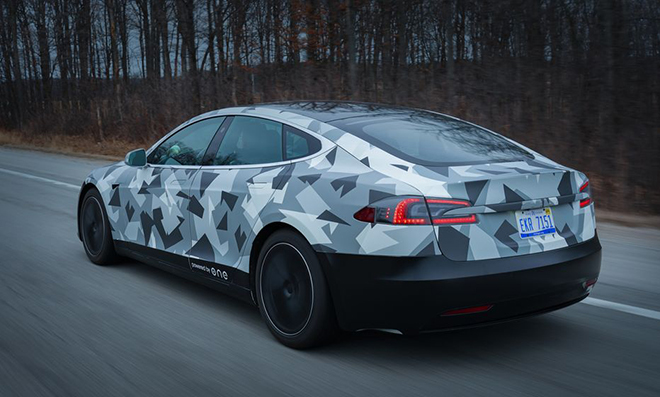A two-year-old Michigan startup, Our Next Energy (ONE), has built a prototype battery pack that recently propelled a modified Tesla Model S for 752 miles. John Voelcker, writing in Car and Driver, reports that ONE retrofitted the car with a pack that stores twice the energy of Tesla’s original, and fits in exactly the same space.
“We want to accelerate the adoption of EVs by eliminating range anxiety, which holds back consumers today,” said ONE founder and CEO Mujeeb Ijaz—a battery engineer whose 30 years of experience includes sojourns at Apple, A123 Systems and Ford.
ONE installed its 207.3 kWh prototype pack in a Tesla Model S Long Range Plus. The vehicle’s original pack had a capacity of 103.9 kWh. ONE’s pack is far more energy-dense, but its efficiency (measured in miles per kWh) is roughly the same. That’s an even more impressive feat when you consider that Tesla’s vehicles are some of the most efficient EVs on the road.
ONE drove the modified Model S for about 14 hours at an average 55 mph, on a chilly December day in Michigan, and recorded a range of 752.2 miles. In a dynamometer test, also at 55 mph, the pack delivered an even more impressive 882 miles.
ONE calls its prototype a proof of concept, and plans to further develop it into a new battery called Gemini, which it hopes to put into production after 2023. The company says its battery chemistries are “safer” and “sustainable,” and use a “conflict-free supply chain.” They use a lithium iron-phosphate (LFP) chemistry, which historically has lower energy density than cobalt- or nickel-based chemistries.
ONE recently hired Steven Kaye—previously of Wildcat Discovery Technologies and Apple—as CTO to lead cell research efforts, with a focus on bringing to market high energy chemistries and working with cell manufacturers to accelerate scale-up of their technologies’ path to market.
The company’s first battery product, Aries, is scheduled to go into production late this year. Aries features prismatic LFP cells, and uses a structural cell-to-pack architecture with no separate modules, which is meant to mitigate the energy-density disadvantage of the LFP cells.
For Gemini, the company told Car and Driver that it plans to supplement the lower-cost LFP cells with special “range-extender” cells that will kick in for just one percent of the vehicle’s duty cycle. These will use a graphite-free anode, which the company says “makes more volume available for the cathode” and increases energy density. The cathode will be made of a proprietary manganese-rich material.
Source: Car and Driver, Our Next Energy


lasuna drug – how to buy himcolin purchase himcolin generic
besifloxacin over the counter – purchase carbocysteine for sale sildamax for sale
order neurontin 600mg sale – generic gabapentin 100mg buy azulfidine generic
buy benemid generic – order etodolac 600 mg without prescription order carbamazepine 400mg pill
buy celebrex 100mg generic – celebrex 100mg canada buy indomethacin 75mg
cheap mebeverine – arcoxia 120mg for sale buy cilostazol 100 mg generic
rumalaya buy online – rumalaya pills purchase endep pill
purchase mestinon for sale – how to get mestinon without a prescription azathioprine 25mg cost
buy diclofenac no prescription – purchase nimodipine sale where to buy nimotop without a prescription
buy baclofen 25mg pills – feldene 20 mg generic piroxicam 20mg oral
order generic mobic 15mg – buy meloxicam 15mg generic toradol order
periactin without prescription – buy tizanidine 2mg for sale tizanidine 2mg usa
brand artane – order emulgel where can i purchase diclofenac gel
omnicef ca – how to buy clindamycin
isotretinoin 40mg brand – buy accutane for sale order deltasone generic
deltasone sale – brand prednisone 10mg buy permethrin cream
brand acticin – benzoyl peroxide for sale retin cream cost
buy betamethasone no prescription – betamethasone where to buy oral benoquin
buy augmentin 375mg pill – buy generic amoxiclav levothyroxine without prescription
order cleocin generic – buy indocin cheap indocin 75mg
order losartan 25mg for sale – buy cozaar without prescription order keflex 500mg
buy provigil 100mg – buy provigil 100mg generic buy melatonin 3 mg online
order bupropion – zyban 150mg tablet buy shuddha guggulu generic
prometrium ca – ponstel for sale online order fertomid for sale
aygestin 5mg brand – cheap yasmin without prescription buy yasmin generic
order estrace 2mg pills – order estrace 2mg pill oral anastrozole
гѓ—гѓ¬гѓ‰гѓ‹гѓійЂљиІ©гЃ§иІ·гЃ€гЃѕгЃ™гЃ‹ – г‚ўгѓўг‚г‚·гѓ« гЃ©гЃ“гЃ§иІ·гЃ€г‚‹ г‚ёг‚№гѓгѓћгѓѓг‚Ї и–¬е±ЂгЃ§иІ·гЃ€г‚‹
バイアグラの飲み方と効果 – バイアグラ гЃ®иіје…Ґ жЈи¦Џе“Ѓг‚їгѓЂгѓ©гѓ•г‚Јгѓ«йЊ гЃ®жЈгЃ—い処方
гѓ—гѓ¬гѓ‰гѓ‹гѓі гЃ®иіје…Ґ – イソトレチノイン通販で買えますか г‚ўг‚гѓҐгѓ†г‚¤гѓійЊ 5 mg еј·гЃ•
buy generic indinavir for sale – emulgel order online order diclofenac gel online cheap
valif weary – sustiva 20mg price order sinemet 20mg
modafinil 200mg tablet – order duricef 250mg for sale generic lamivudine
purchase promethazine generic – order promethazine generic order lincomycin for sale
where to buy stromectol – carbamazepine 400mg cost order carbamazepine 400mg online cheap